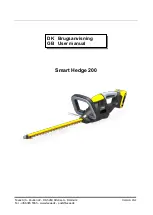
GB-13
Fig.3-3
Spark plug (Fig. 3-3)
The spark plug condition is influenced by:
An incorrect carburetor setting.
Wrong fuel mixture (too much oil in the gasoline)
A dirty air filter.
Hard running conditions (such as cold weather).
These factors cause deposits on the spark plug
electrodes, which may result in malfunction and
starting difficulties. If the engine is low on power,
difficult to start or runs poorly at idling speed,
always check the spark plug first. If the spark plug
is dirty, clean it and check the electrode gap.
Readjust if necessary. The correct gap is 0.6 mm.
The spark plug should be replaced after about
100 operation hours or earlier if the electrodes
are badly eroded.
NOTE!
In some areas, local law requires using a resistor
spark plug to suppress ignition signals. If this
machine was originally equipped with resistor
spark plug, use same type of spark plug for
replacement.
Muffler (Fig. 3-4)
Remove the muffler and clean out any excess
carbon from the exhaust port or muffler inlet every
100 hours of operation.
Cylinder (Engine cooling) (Fig. 3-4B)
The engine is air cooled, and air must circulate
freely around engine and over cooling fins on
cylinder head to prevent overheating.
Every 100 operating hours, or once a year,
(more often if conditions require) clean fins and
external surfaces of engine of dust, dirt and oil
deposits which can contribute to improper cooling.
NOTE!
Do not operate engine with engine shroud or
muffler guard removed as this will cause
overheating and engine damage.
Fig.3-4
Fig.3-4B
Angle transmission (Fig.3-5)
Check angle transmission or angle gear for
grease level about every 50 hours of operation
by removing the grease filler plug on the side of
angle transmission.
If no grease can be seen on the flanks of the
gears, fill the transmission with quality lithium
based multipurpose grease up to 3/4.
Do not completely fill the transmission.
Blade (Fig. 3-6)
WARNING!
Wear protective gloves when handling or
performing maintenance on the blade.
Use a sharp blade. A dull blade is more likely
to snag and thrust. Replace the fastening nut
if it is damaged and hard to tighten.
When replacing blade, purchase one
recommended by HITACHI, with a 25.4mm
(one inch) fitting hole.
When installing saw blade (2), always face the
stamped side up. In the case of a 3 or 4 tooth
blade (1, 3), it can be used on either side.
Use correct blade for the type of work.
When replacing blade, use appropriate tools.
When cutting edges become dull, re-sharpen
or file as shown in figure. Incorrect sharpening
may cause excessive vibration.
Discard blades that are bent, warped, cracked,
broken or damaged in any way.
NOTE!
When sharpening blade it is important to maintain
an original shape of radius at the base of the
tooth to avoid cracking.
Maintenance schedule
Below you will find some general maintenance
instructions. For further information please
contact HITACHI dealer.
Daily maintenance
Clean the exterior of the unit.
Check that the harness is undamaged.
Check the blade guard for damage or cracks.
Change the guard in case of impacts or
cracks.
Check that the cutting attachment is properly
centred, sharp, and without cracks. An off-
centred cutting attachment induces heavy
vibrations that may damage the unit.
Check that the cutting attachment nut is
sufficiently tightened.
Make sure that the blade transport guard is
undamaged and that it can be securely fitted.
Check that nuts and screws are sufficiently
tightened.
Weekly maintenance
Check the starter, especially cord and return
spring.
Clean the exterior of the spark plug.
Remove it and check the electrode gap.
Adjust it to 0.6 mm, or change the spark plug.
Clean the cooling fins on the cylinder and
check that the air intake at the starter is not
clogged.
Check that the angle gear is filled with grease
up to 3/4.
Clean the air filter.
Monthly maintenance
Rinse the fuel tank with gasoline.
Clean the exterior of the carburetor and the
space around it.
Clean the fan and the space around it.
1
3
2
Fig.3-5
Fig.3-6
Summary of Contents for CG47EJ
Page 114: ...PRINTED IN JAPAN ...















































